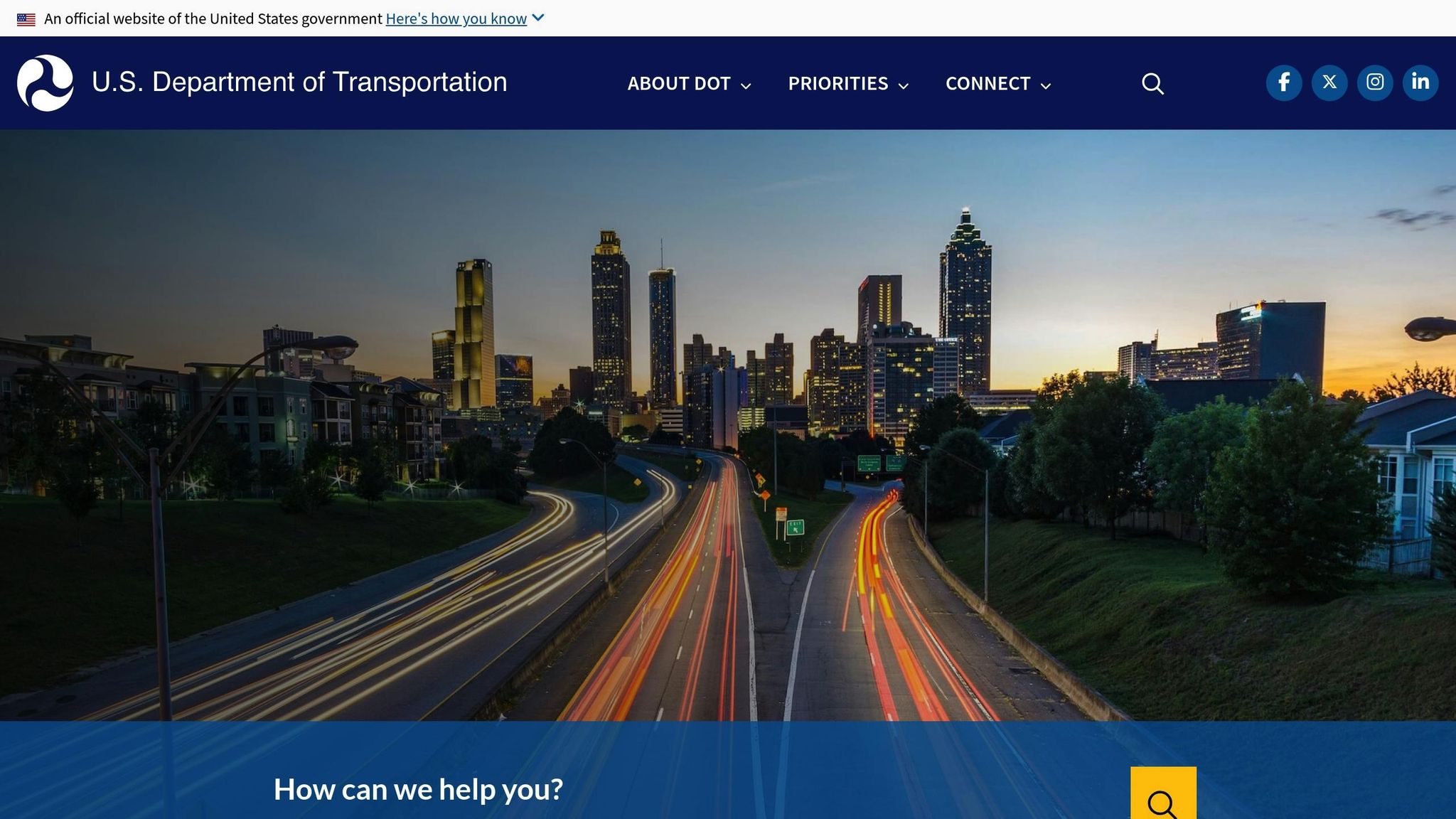FMCSA Hours of Service Rules Explained

FMCSA Hours of Service (HOS) rules are federal regulations designed to prevent driver fatigue and ensure road safety for commercial drivers and the public. These rules set strict limits on driving hours, work periods, and required rest breaks for drivers of commercial motor vehicles (CMVs), especially those involved in interstate commerce.
Key Takeaways:
- 14-Hour Workday Limit: Drivers have 14 consecutive hours to complete all work tasks, followed by a 10-hour rest.
- 11-Hour Driving Limit: Within the 14-hour window, drivers can drive for up to 11 hours.
- 30-Minute Break: A mandatory 30-minute break is required after 8 hours of driving.
- Weekly Hour Caps:
- 60 hours in 7 days or 70 hours in 8 days.
- A 34-hour rest resets weekly limits.
- Sleeper Berth Rules: Drivers can split their 10-hour rest into two segments (e.g., 7+3 hours).
Who Must Comply?
- Drivers of CMVs weighing 10,001+ lbs
- Moving companies handling interstate moves
- Household goods carriers transporting personal items
Exceptions:
- Short-Haul Drivers: Within a 150 air-mile radius, with adjusted rules.
- Bad Weather: Delays due to weather must be documented.
- Personal Use: Non-business vehicle use doesn’t count against HOS limits.
Why It Matters:
HOS rules reduce fatigue-related accidents, protect drivers and others on the road, and help companies avoid fines. Tools like Electronic Logging Devices (ELDs) make compliance simpler by tracking driving hours automatically.
DOT Hours of Service Explained 2024: Clock, Sleeper Berth ...

Main HOS Rules
The FMCSA has set specific rules for work hours and rest periods that moving company drivers must follow. These guidelines help ensure driver safety and reduce the risk of fatigue-related incidents by structuring work and rest times.
14-Hour Work Limit
The 14-hour rule defines how long a driver can be on duty in a single workday. Once a driver begins their shift, they have 14 consecutive hours to complete all work-related tasks, including:
- Loading and unloading
- Vehicle inspections
- Paperwork
- Fueling
- Any other job-related duties
After this 14-hour window ends, drivers must take at least 10 consecutive hours off before starting their next shift. This rule applies even if the driver hasn't used all their allowed driving hours. The following 11-hour driving rule explains how this work window is divided.
11-Hour Driving Maximum
Drivers can spend up to 11 hours driving within the 14-hour work window. The remaining time can be used for other tasks.
| Activity Type | Time Limit |
|---|---|
| Driving | Up to 11 hours |
| Other On-Duty Tasks | Up to 3 hours |
| Required Rest Period | 10 hours |
Required 30-Minute Breaks
After 8 straight hours of driving, drivers must take a 30-minute break. This break can be taken off-duty or in a sleeper berth, but it cannot be split into smaller chunks. It must be completed before the driver reaches the 8-hour driving mark.
Weekly Hour Limits
Drivers must also comply with weekly hour restrictions based on their schedule:
| Schedule Type | Hour Limit | Time Frame |
|---|---|---|
| 7-Day Week | 60 hours | Any 7 consecutive days |
| 8-Day Week | 70 hours | Any 8 consecutive days |
To reset their weekly hours, drivers can take a 34-hour consecutive rest period, often called the "34-hour restart." For those using sleeper berths, additional rest options are outlined below.
Sleeper Berth Rules
Drivers can split their required 10-hour rest into two segments: at least 7 hours in the sleeper berth and 2 hours either off-duty or in the sleeper berth. Both segments must occur before the next 14-hour work window begins.
These two rest periods must add up to at least 10 hours, and neither segment counts against the 14-hour workday limit.
Rule Exceptions
The FMCSA enforces strict Hours of Service (HOS) regulations, but there are specific exceptions that allow moving companies to adjust operations under certain conditions.
Short-Distance Rules
Drivers working within a 150 air-mile radius of their home base may qualify for a short-haul exception, which modifies some standard HOS rules.
| Short-Haul Exception Details | Requirements |
|---|---|
| Maximum Work Day | 14 consecutive hours |
| Return-to-Base | Must start and end at the same location |
| Distance Limit | 150 air-miles from the home base |
| Recordkeeping | Paper logs allowed if criteria are met |
| Weekly Limits | Standard 60/70-hour rules still apply |
Under this exception, drivers must begin and end their day at the same location and stay within the specified radius. This is often used for local moves or deliveries in urban areas. Other exceptions address weather challenges or trips unrelated to business operations.
Bad Weather Allowances
Unexpected weather conditions require drivers to document delays with detailed notes. While standard HOS limits remain unchanged, drivers must prioritize safety and keep thorough records of weather-related disruptions.
Personal Use Rules
The FMCSA also differentiates between business and personal travel. Drivers can use their commercial vehicles for personal reasons without it affecting their HOS limits, provided it’s not related to business activities.
| Approved Personal Use | Prohibited |
|---|---|
| Driving home after work | Moving loads |
| Traveling to a restaurant or lodging | Positioning vehicles for loading |
| Running personal errands | Business-related travel |
| Commuting to or from work | Advancing loads toward a destination |
To comply, drivers must:
- Ensure the vehicle is off-duty
- Use it strictly for personal purposes
- Clearly annotate logs to show personal trips
- Confirm the trip is unrelated to business
Clear communication of these rules is essential for moving companies to avoid accidental HOS violations.
sbb-itb-290b89d
Following HOS Rules
Staying compliant with FMCSA Hours of Service (HOS) regulations is crucial for moving companies. A major part of this is using Electronic Logging Devices (ELDs), which automatically track driving time and duty status changes. These devices ensure accurate records, which are essential during FMCSA audits. Additionally, companies must maintain detailed records to show they are following these rules.
HOS violations can lead to hefty fines, so companies should focus on three key practices: training drivers on current HOS rules, regularly using ELDs to track duty status, and keeping detailed operational records. Taking these steps not only helps avoid penalties and disruptions but also promotes safer roads for everyone.
MOD24's Compliance Tools

MOD24 provides tools specifically designed to help moving companies stay compliant with regulations. By focusing on dependable partnerships and organized scheduling, MOD24 supports moving companies in meeting FMCSA Hours of Service requirements while running smoothly.
Licensed Mover Network
MOD24 includes a network of moving companies that have been thoroughly checked to ensure they are licensed and insured. This detailed verification process ensures customers are connected with movers who adhere to federal regulations and prioritize safety and dependability.
Schedule Management
Easily book moves in less than 10 minutes, simplify planning, and reduce scheduling conflicts. MOD24 also offers top-notch customer support for changes, cancellations, or rescheduling, ensuring businesses stay aligned with FMCSA Hours of Service rules.
Conclusion
Following FMCSA Hours of Service (HOS) rules is crucial for ensuring driver safety and keeping operations running smoothly. These rules protect drivers, improve customer experience, and help maintain efficient workflows.
Here’s a quick breakdown of HOS compliance essentials:
- Drivers have a 14-hour work window with an 11-hour driving limit and must take a 30-minute break after 8 consecutive hours of driving.
- Weekly driving limits are capped at 60 hours over 7 days or 70 hours over 8 days, depending on the schedule.
For moving companies, staying compliant involves:
- Active monitoring: Using Electronic Logging Devices (ELDs) to track driving hours.
- Accurate documentation: Maintaining detailed records of all driving activities.
- Smart scheduling: Planning trips within HOS limits.
By strictly adhering to these rules, companies can avoid violations, improve safety on the road, and enhance overall efficiency.
Using tools like MOD24’s licensed mover network and scheduling features can make compliance easier. These tools help moving companies manage operations while staying within HOS guidelines.

How To File A Complaint With FMCSA
Filing a complaint with the FMCSA is straightforward and can help resolve issues with interstate mo...

5 Best Moving Companies for Military Families
Relocating under PCS (Permanent Change of Station) orders can be stressful for military families. T...

Are Moving Companies Essential Businesses in the Age of Covid-19 Pandemic
The coronavirus pandemic still rages across the US, disrupting everyday life and forcing many busine...